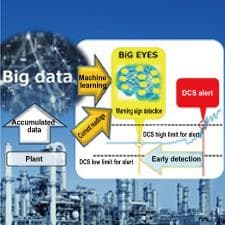Online Anomaly Monitoring System BiG EYES™
Brand: Azbil North America, IncThe innovation of the IoT (Internet of things) has created cyber-physical systems and has begun to function as an infrastructure that creates new value.
In our data-driven society, big data is in the spotlight as a new corporate resource, and it is expected to play a key role in reinforcing corporate competitiveness.
One area in which big data is applied in the manufacturing industry is in facility management.
BiG EYES utilizes big data from operations at the manufacturing site to teach fuzzified neural networks (FNN) about the normal operating behavior of various types of equipment.
By doing so, it enables real-time discovery of anomalies (warning signs of future problems).
It is an anomaly warning monitoring system that prevents problems by detecting equipment warning signs at an early stage.
Features- Detection and quick notification of anomalies (warning signs) in equipment activity anywhere in the plant/factory
- The system utilizes long-term process data (big data) that has been collected by the PIMS to automatically generate a model that has been taught the normal sensor readings (PV) and control output (MV/OP) from PID controllers.
- Anomalous behavior (warning signs) from failing or defective equipment, etc., are quickly detected by this model, and notification is sent to operators.
- The detection mechanism seems to have the intuition of a veteran operator
- A nonlinear regression model utilizing a fuzzy neural network outputs estimates with confidence intervals.
- It calculates expected values using inclusion relations of estimates with confidence intervals of actual values, and then visualizes the percentage of deviation from normal behavior.
- System architecture can be modified, operated, and maintained by the user
- A full range of tasks available on the configurator—from defining the monitoring system to evaluating estimates.
- Once a model is created, it is automatically updated every 24 hours, so estimates are always generated with the newest model.





